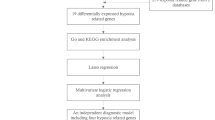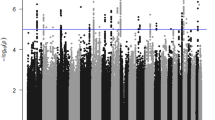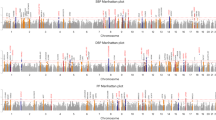Abstract
The goals of our study were to evaluate the haplotype pattern at the Rho-associated kinase 2 (ROCK2) locus and prospectively test the association between the ROCK2 haplotype-tagging single-nucleotide polymorphisms (tagSNPs) with hypertension for verified incident hypertensive patients (n =607) and healthy, normotensive controls (n =586) in a HYPGENE study. Rho-associated kinases (ROCKs) play a central role in signaling pathways that are involved in vascular smooth muscle contraction and endothelial nitric oxide availability. Using a set of stringent criteria (minor allele frequency ≥0.05, pairwise r 2≥0.95), we identified 18 tagSNPs from the 109 SNPs available in the HapMap Caucasian data set. TagSNPs were genotyped using the Illumina BeadStation platform. The 18 tagSNPs consisted of two linkage disequilibrium (LD) blocks. A haplotype defined by four SNPs (rs965665, rs10178332, rs6755196, rs10929732) in LD block 2 was recessively associated with a lower risk of hypertension (p =0.003). Homozygotes for the minor alleles had an 85% lower risk of hypertension than carriers of the common allele. The associations were independent of baseline age, cardiorespiratory fitness, body mass index, sex, and follow-up time. The LD block 2 spans about 137 kb of genomic DNA at the 5'-end of the ROCK2 locus and covers exons encoding the kinase domain of the protein. Our data strongly suggest that a major haplotype block at the ROCK2 locus is recessively associated with a lower risk of hypertension. Identification of functional mutation(s) could thus help in the development of ROCK2-specific treatments.
Similar content being viewed by others
Article PDF
References
Noma K, Oyama N, Liao JK : Physiological role of ROCKs in the cardiovascular system. Am J Physiol Cell Physiol 2006; 290: C661–C668.
Kureishi Y, Kobayashi S, Amano M, et al: Rho-associated kinase directly induces smooth muscle contraction through myosin light chain phosphorylation. J Biol Chem 1997; 272: 12257–12260.
Kimura K, Ito M, Amano M, et al: Regulation of myosin phosphatase by Rho and Rho-associated kinase (Rhokinase). Science 1996; 273: 245–248.
Nohria A, Grunert ME, Rikitake Y, et al: Rho kinase inhibition improves endothelial function in human subjects with coronary artery disease. Circ Res 2006; 99: 1426–1432.
Masumoto A, Hirooka Y, Shimokawa H, Hironaga K, Setoguchi S, Takeshita A : Possible involvement of Rhokinase in the pathogenesis of hypertension in humans. Hypertension 2001; 38: 1307–1310.
Uehata M, Ishizaki T, Satoh H, et al: Calcium sensitization of smooth muscle mediated by a Rho-associated protein kinase in hypertension. Nature 1997; 389: 990–994.
Seasholtz TM, Wessel J, Rao F, et al: Rho kinase polymorphism influences blood pressure and systemic vascular resistance in human twins: role of heredity. Hypertension 2006; 47: 937–947.
Rankinen T, Church TS, Rice T, Blair SN, Bouchard C : Cardiorespiratory fitness, BMI, and risk of hypertension: the HYPGENE Study. Med Sci Sports Exerc 2007; 39: 1687–1692.
Perloff D, Grim C, Flack J, et al: Human blood pressure determination by sphygmomanometry. Circulation 1993; 88: 2460–2470.
Balke B, Ware RW : An experimental study of physical fitness in Air Force personnel. US Armed Forces Med J 1959; 10: 675–688.
de Bakker PI, Yelensky R, Pe'er I, Gabriel SB, Daly MJ, Altshuler D : Efficiency and power in genetic association studies. Nat Genet 2005; 37: 1217–1223.
Wigginton JE, Cutler DJ, Abecasis GR : A note on exact tests of Hardy-Weinberg equilibrium. Am J Hum Genet 2005; 76: 887–893.
Abecasis GR, Cookson WO : GOLD—graphical overview of linkage disequilibrium. Bioinformatics 2000; 16: 182–183.
Gabriel SB, Schaffner SF, Nguyen H, et al: The structure of haplotype blocks in the human genome. Science 2002; 296: 2225–2229.
Barrett JC, Fry B, Maller J, Daly MJ : Haploview: analysis and visualization of LD and haplotype maps. Bioinformatics 2005; 21: 263–265.
Stephens M, Smith NJ, Donnelly P : A new statistical method for haplotype reconstruction from population data. Am J Hum Genet 2001; 68: 978–989.
Stephens M, Donnelly P : A comparison of bayesian methods for haplotype reconstruction from population genotype data. Am J Hum Genet 2003; 73: 1162–1169.
Li M, Boehnke M, Abecasis GR : Efficient study designs for test of genetic association using sibship data and unrelated cases and controls. Am J Hum Genet 2006; 78: 778–792.
Nyholt DR : A simple correction for multiple testing for single-nucleotide polymorphisms in linkage disequilibrium with each other. Am J Hum Genet 2004; 74: 765–769.
Rana BK, Insel PA, Payne SH, et al: Population-based sample reveals gene-gender interactions in blood pressure in White Americans. Hypertension 2007; 49: 96–106.
Loirand G, Guerin P, Pacaud P : Rho kinases in cardiovascular physiology and pathophysiology. Circ Res 2006; 98: 322–334.
Sebbagh M, Hamelin J, Bertoglio J, Solary E, Breard J : Direct cleavage of ROCK II by granzyme B induces target cell membrane blebbing in a caspase-independent manner. J Exp Med 2005; 201: 465–471.
Kacser H, Burns JA : The molecular basis of dominance. Genetics 1981; 97: 639–666.
Author information
Authors and Affiliations
Corresponding author
Rights and permissions
About this article
Cite this article
Rankinen, T., Church, T., Rice, T. et al. A Major Haplotype Block at the Rho-Associated Kinase 2 Locus Is Associated with a Lower Risk of Hypertension in a Recessive Manner: The HYPGENE Study. Hypertens Res 31, 1651–1657 (2008). https://doi.org/10.1291/hypres.31.1651
Received:
Accepted:
Issue date:
DOI: https://doi.org/10.1291/hypres.31.1651
Keywords
This article is cited by
-
Potential Benefits of Rho-kinase Inhibition in Arterial Hypertension
Current Hypertension Reports (2013)
-
The role of Rho protein signaling in hypertension
Nature Reviews Cardiology (2010)
-
Rho-kinase inhibitors as therapeutics: from pan inhibition to isoform selectivity
Cellular and Molecular Life Sciences (2010)



